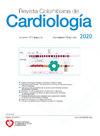多血管冠状动脉血栓形成和急性心肌梗死与两种基因突变有关
Q4 Medicine
引用次数: 0
摘要
几项研究表明,来自血栓病的基因突变可能构成冠状动脉疾病的重要危险因素,特别是在冠状动脉正常和无显著病变的年轻患者中。这是一个42岁的男性患者谁到达急诊室由于急性心肌梗死的情况下。心电图示ST段抬高,V1至V4上凸4mm, V5、V6上凸1mm。心肌酶阳性(肌钙蛋白I 8.4 ng/dl,正常范围< 1 ng/dl)。发现鼻中隔和鼻尖运动减退,射血分数44%。对梗死的罪魁祸首病变进行了初级血管成形术治疗,成功地扩张了左冠状动脉前降支。然而,自发性血栓出现在旋动脉的中间三分之一处,该区域以前没有闭塞性病变。血栓形成前状态疾病的全面实验室评估显示,亚甲基四氢磷酸还原酶(MTHFR)和纤溶酶原激活物抑制剂-1 (PAI-1)的A1298C基因突变呈阳性。急性冠状动脉综合征的年轻患者应考虑来自MTHFR和PAI-1的A1298C基因突变,主要是在非罪魁祸首动脉中发现血栓,无冠状动脉病变或无显著冠状动脉病变。本文章由计算机程序翻译,如有差异,请以英文原文为准。
Multivessel coronary thrombosis and acute myocardial infarction associated to two genetic mutations for thrombophilia
Several studies suggest that gene mutations from thrombophilia may constitute a significant risk factor for coronary artery disease, especially in young patients with normal coronaries and non-significant lesions. It is presented a case of a 42-year-old male patient who arrived at the emergency room due to an acute myocardial infarction. The electrocardiogram showed an ST elevation with upward convexity of 4 mm from V1 to V4 and of 1 mm at V5 and V6. Cardiac enzymes were positive (troponin I 8.4 ng/dl, normal range < 1 ng/dl). It was found septum and apical hypokinesia, with an ejection fraction of 44%. The culprit lesion of the infarction was treated with primary angioplasty, successfully dilating the left anterior descending coronary artery. However, spontaneous thrombi appeared at the middle third of the circumflex artery, an area without occlusive lesions previously. A full laboratory assessment for prothrombotic state diseases revealed positivity for gene mutations at A1298C from the methylene tetrahydropholate reductase (MTHFR) and plasminogen activator inhibitor-1 (PAI-1). Gene mutations at A1298C from the MTHFR and PAI-1 should be considered in young patients with acute coronary syndrome, mainly when thrombi are found in non-culprit arteries with no or non-significant coronary lesions.
求助全文
通过发布文献求助,成功后即可免费获取论文全文。
去求助
来源期刊

Revista Colombiana de Cardiologia
Medicine-Cardiology and Cardiovascular Medicine
CiteScore
0.50
自引率
0.00%
发文量
90
审稿时长
80 weeks
期刊介绍:
The Colombian Cardiology Review is an official publication of the Colombian Cardiology and Cardiovascular Surgery Society, emitted bimonthly. Its uninterrupted circulation was initiated in 1985. The main objective of the review is the publication of the scientific, investigative, academic and administrative activities of the society members, of the medical professionals or of those connected with the health sector, nationals or foreigners, that may be working in the Cardiology field or related sciences.
 求助内容:
求助内容: 应助结果提醒方式:
应助结果提醒方式:


